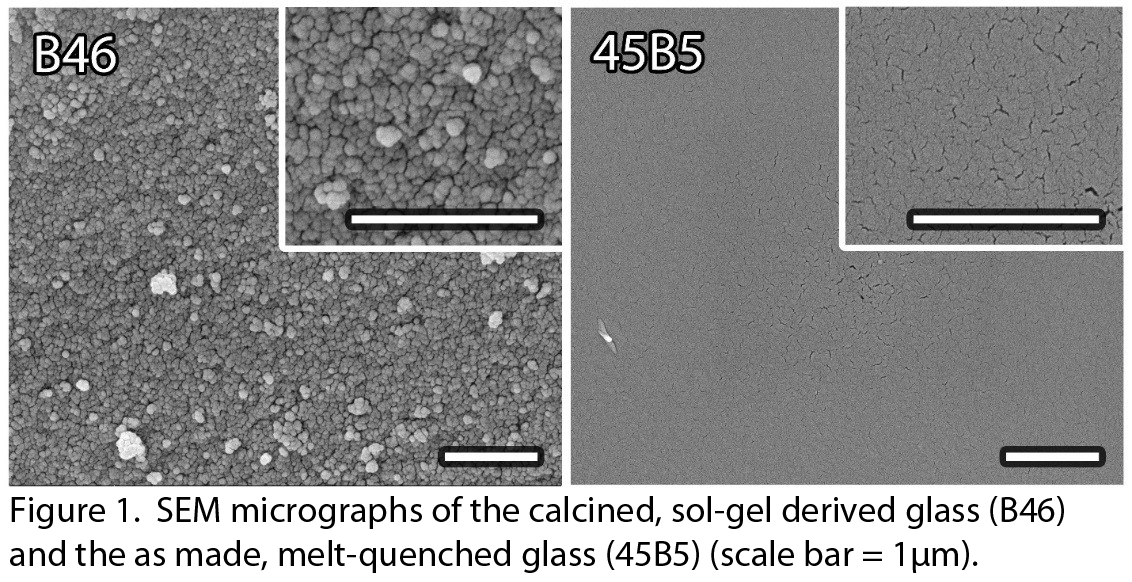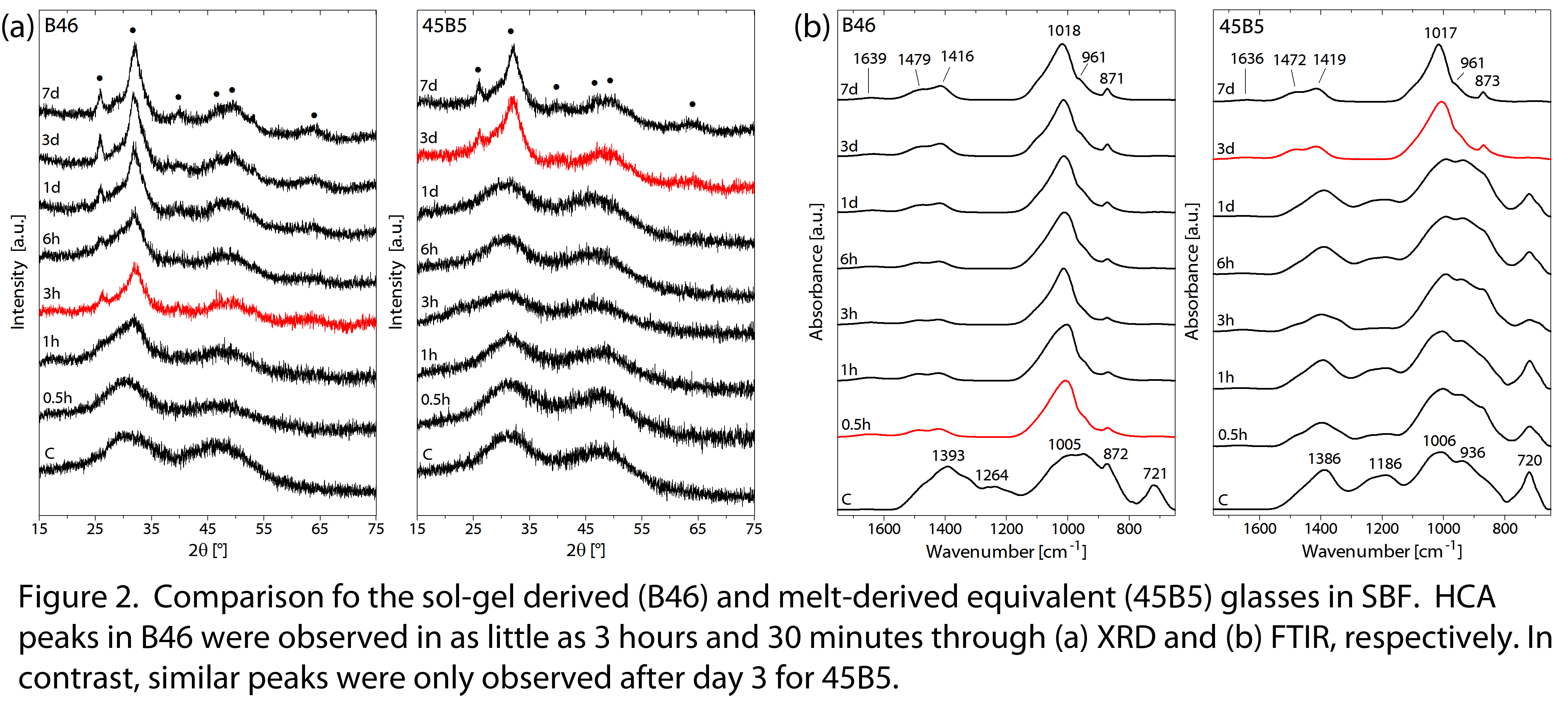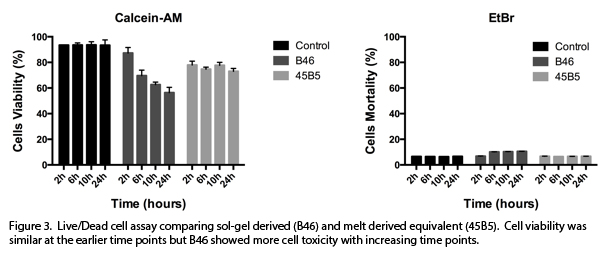Introduction: Owing to their lower chemical durability, borate glasses degrade more rapidly and consequently have a quicker conversion rate to bone-like hydroxy-carbonated apatite (HCA) when compared to bioactive silicate glasses[1]. Moreover, sol-gel derived glasses impart increased surface area and porosity, both of which are desirable for tissue engineering applications[2]. However, non-silicate based sol-gel glasses have rarely been investigated. In this study, we developed sol-gel derived, bioactive borate glasses (SGBGs) and investigated the effect of the different processing characteristics on reactivity and in vitro bioactivity.
Material and Methods: The gel- and glass-forming ability of a SGBG (B46) based on a previously studied four component melt-derived glass (45B5) system [(46.1)B2O3–(26.9)CaO–(24.4)Na2O–(2.6)P2O5; mol %] was investigated. For the sol-gel process, boric acid was dissolved in ethanol under mild heating followed by the addition of triethyl phosphate, calcium methoxyethoxide (20% in methoxyethanol), and sodium methoxide (25 wt% in methanol) at 30-minute intervals. The sol was then cast to gel and aged at different time points. Post ageing and drying, the glasses were calcined at different temperatures and dwell times. Porosity and specific surface area were measured using the B.J.H. and B.E.T. method, respectively. The aqueous interactions of the glasses were examined by dynamic vapour sorption (DVS) while the bioactivity was studied in simulated body fluid (SBF)[3]. Ion release was measured using Inductively Coupled Plasma Optical Emission Spectrometry in deionized water (ICP-OES). Glass structure, before and after SBF immersion, was examined by ATR-FTIR and XRD while morphology changes were observed via SEM. The response of mesenchymal stem cells (MSCs) to the glasses and their ionic release products were also investigated.
Results: Monolithic gels were successfully created with the sol-gel method using different processing parameters. The length of gelation had little influence on the glass structure and the as-made, dried particles maintained their amorphous nature after calcination at 400 °C. However, upon higher crystallization temperatures the glasses began to crystalize while surface area and pore volume decreased. Morphological characterization using SEM demonstrated the different surfaces obtained through sol-gel and melt-quenched processing (Figure 1).

SBF conditioning of the sol-gel fabricated glass (B46) resulted in a carbonated-phosphate peak within 30 minutes through ATR-FTIR, and HCA formation in 3 hours according to XRD (Figure 2). In contrast, 45B5 took 3 days to indicate HCA formation. This difference in conversion rates can be attributed to the rapid ion release profiles shown through ICP.

Cell viability using a Live/Dead assay indicated that B46 and 45B5 had similar toxicity at early time points but cell viability decreased more with the B46 likely due to the rapid ion release (Figure 3).

Discussion: It is possible to tailor the reactive and bioactive properties of SGBGs by changing the processing parameters. By changing the calcination temperature, the surface area and porosity can be altered allowing for tailored therapeutic effects. Additionally, SGBGs are significantly more reactive and bioactive compared to their melt-derived equivalents, demonstrating at least 25 fold increase in HCA conversion rates.
Conclusions: The ability to fabricate bioactive borate glasses derived from the sol-gel process has been reported. These glasses rapidly convert to HCA in SBF due to their increased surface area and porosity which allows for rapid ion release rates. The ability to tailor SGBGs from processing makes these glasses desirable for not only bone tissue engineering, but other regenerative medicine applications.
Funding of NSERC, CFI, Quebec MEIE, and McGill University Faculty of Engineering Gerald Hatch Faculty Fellowship are gratefully acknowledged. WCL and GG is partially supported by MEDA fellowship and FQRNT Doctoral Research Grant.
References:
[1] Huang W, Day DE, Kittiratanapiboon K, Rahaman MN. Kinetics and mechanisms of the conversion of silicate (45S5), borate, and borosilicate glasses to hydroxyapatite in dilute phosphate solutions. Journal of Materials Science: Materials in Medicine. 2006;17(7):583-96
[2] Jones JR. Review of bioactive glass–from Hench to hybrids. Acta Biomaterialia. 2012:9(1):4457-86.
[3] Kokubo T, Takadama H. How useful is SBF in predicting in vivo bone bioactivity? Biomaterials. 2006;27(15):2907-15.